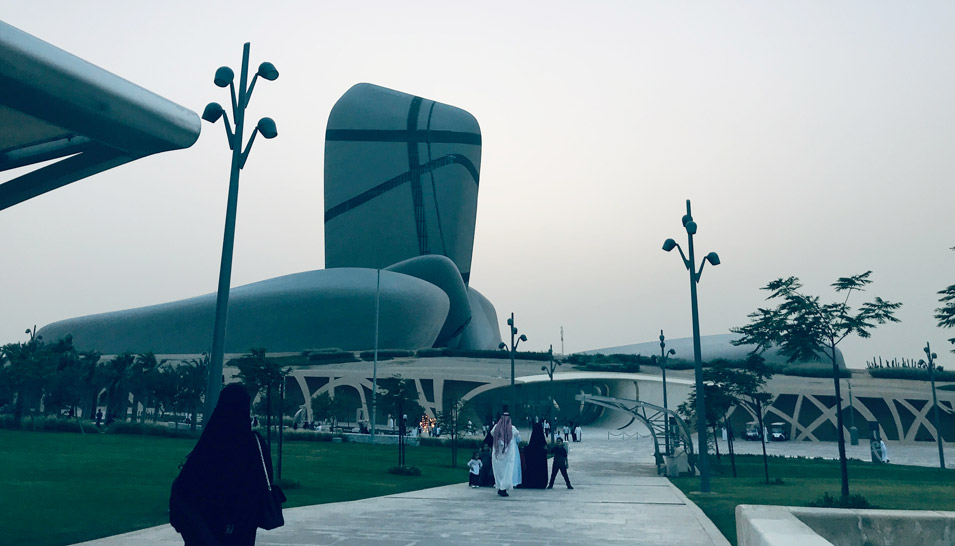
"We launched a global architectural competition, inviting some of the world’s best-known architects to come up with designs for the Center. We ultimately chose the Norwegian architectural firm Snøhetta, whose idea contained multiple layers of symbolism and was inspired by the main business of our company: energy.
The design focuses on the geological nature of the Kingdom, using an assortment of different-sized “rocks”, which symbolize diversity. These rocks lean on one another to illustrate solidarity, and show that the various disciplines explored in the building all depend on one another. The design even extends to the layout of the content housed within, placing inspiration from the past in the rocks underground, the present at ground level, and the future soaring up into the sky."
~Saudi Aramco

In 2018, I had the chance to visit the Ithra Museum—otherwise known as the King Abdulaziz Center for World Culture. The 80,000 square meters building was built by Saudi Aramco in December 2016 as a corporate social responsibility initiative that focuses on promoting cross-culture activities, human development, and creativity. The Arabic word “Ithra” means “enrichment,” and this phrase accurately defines the nature of the museum and its objective to enrich the region culturally.





All visitors to the museum know that the architectural structure of the building is breathtaking, and it’s not for any random reason. The design of the building symbolizes the geological structure of the Kingdom—rocks. The various rocks in the structure are reflective of the diverse array of rocks that are present in the Kingdom’s land.

“Wasl Beyond the Pen,” celebrating Arabic calligraphy





Essentially, the museum is dedicated to showcasing contemporary Middle Eastern art, Islamic Art and Scripture, Saudi Culture, and the Natural History of the Arabian Peninsula. There are four galleries within the museum, respective to each of the aforementioned four categories.

Arabian Horse Sculpture

Aramco Truck

Desert on a screen

Bowl from Syria, late 12th or early 13th century.

Desert Rose

Ewer, from Iran, Kashan, late 12th or early 13th century.

Fritware, underglaze-painted. Turkey, Iznik, early 16th century.

Gold bracelet set with rubies and emeralds. Egypt or Syria, 11th century.

Pair of candlesticks, eastern Mediterranean, late 15th or early 16th century.



Tin-glazed earthenware (maiolica), from Spain, Manises, c. 1430–50.


The museum at Ithra isn’t limited to the galleries that showcase artwork—lectures, exhibitions, live music, and individualized tours are all part of the experience. I was particularly fascinated by the Rehlaat Gallery at Ithra. This gallery focuses on the history of the region and highlights the geography of the Arabian Peninsula. It harbors the various species of animals, flora, fauna, and scenic landscape—whether it is the desert, mountains, or the coasts.

Maps and reference books used to scout for oil in the desert.

Polycrystalline Diamond Compact (PDC). It was designed for use in Saudi Aramco’s Khurais Field.

Smallest Polycrystalline Diamond Compact Bit used in Saudi Arabia.
I also remember spending a lot of time looking at the 3-D drilling equipment that was showcased at the museum. My dad, who was in the Drilling Department, helped explain exactly what the machinery’s role was in the oil-extraction process.

A music session was underway at Ithra on June 23, 2018.
On my way out, I was lucky to hear some live music being played by a group of men. It added a beautiful melody to my informative and fascinating visit to the museum. For those living in Saudi Arabia right now, I highly recommend visiting Ithra if you haven’t already!

Anushka is a Graduate Student at Korbel School of International Studies at the University of Denver. She spent her youth growing up in Dhahran, where she attended Dhahran Elementary, Dhahran Middle School, and Dhahran Academy. She loves learning about new cultures and is fascinated by the diversity that brings us all together, especially the expatriate community, where the only thing that is common is that we are all different, in culture, religion, and the perspectives we hold. One day she hopes to publish a book on the third culture kid experience. Dhahran holds a big place in her heart.